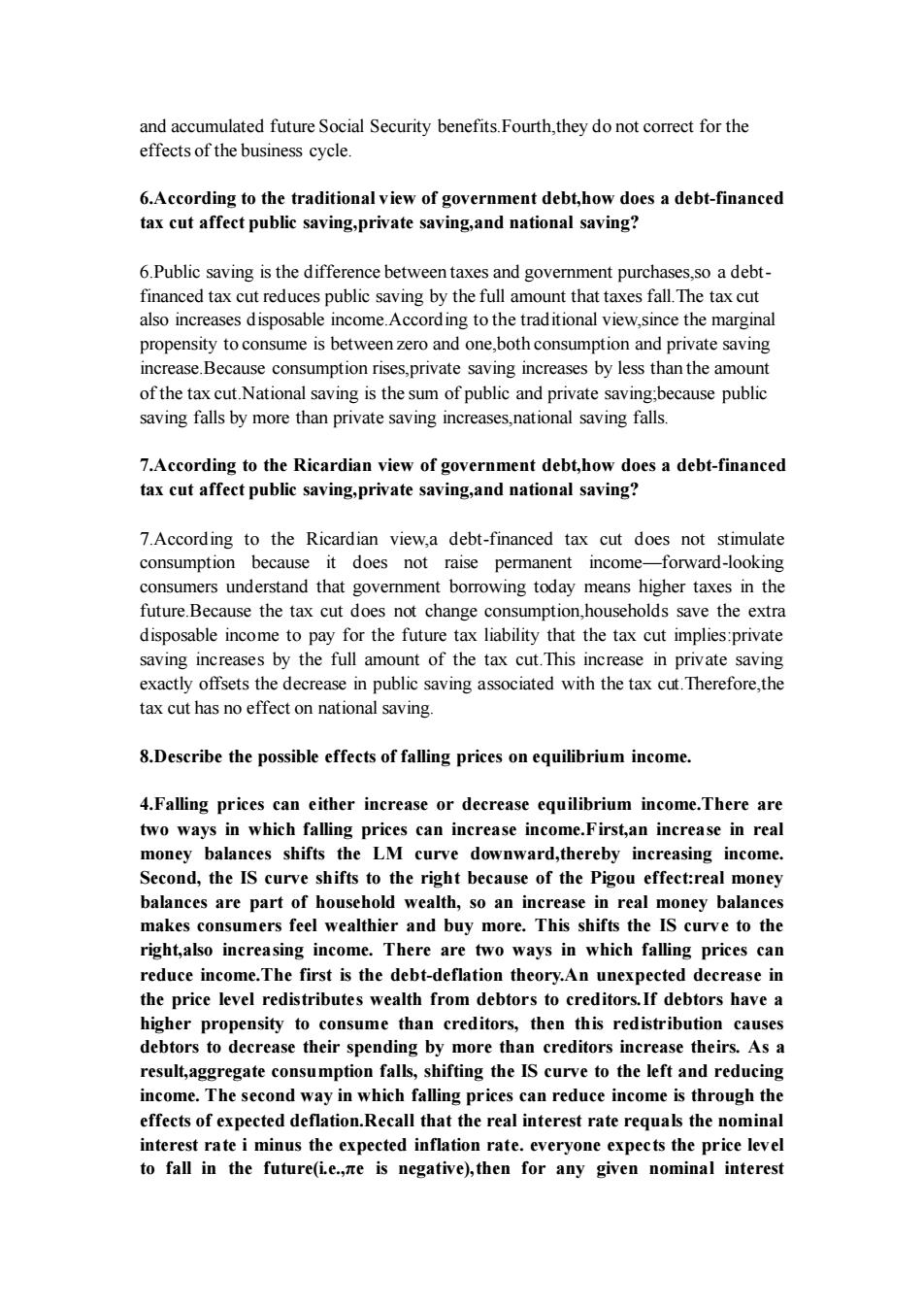正在加载图片...

effects of the business cycle 6.According to the traditional view of government debt,how does a debt-financed tax cut affect public saving,private saving and national saving? 6.Public saving is the difference betweent xes and goverment purcha s.so a debt financed tax cut reduces public saving by the full amount that taxes fall.The tax cut also increases disposable income.According to the traditional view,since the marginal propensity to consume is between zero and one,both consumption and private saving increase Because consumption rises private saving increases by less than the amount of the tax cut National saving is the sum of public and pri ate g.because public nfalls by more than private saving national ing falls 7.According to the Ricardian view of government debt,how does a debt-financed tax cut affect public saving.private saving.and national saving? 7.According to the Ricardian view,a debt-financed tax cut doe not s stimulate consumption because it does not raise permanent income forward-looking consumers understand that government borrowing today means higher taxes in the future.Because the tax cut does not change consumption,households save the extra disposable income to pay for the future tax liability that the tax cut implies:private e the full ame of the tax cut.This in pr exactly offsets t e decrease in public saving associated with the tax cut.Therefore,the tax cut has no effect on national saving. 8.Describe the possible effects of falling prices on equilibrium income. 4.Falling prices can either increase or decrease equilibrium income.There are two ways in which falling prices can increase income.First,an increase in real money balances shifts the LM curve downward,thereby increasing income. Second,the Is curve shifts to the right because of the Pigou effect:real money balances are part of household wealth,so an increase in real money balanc sumer s feel and buy more. This shifts the IS curve to the right,also increasing income.There are two ways in which falling prices can reduce income.The first is the debt-deflation theorv.An unexpected decrease in the price level redistributes wealth from debtors to creditors.If debtors have a higher propensity to consume than creditors,then this redistribution causes debtors to de thei din thar edito theirs As result,aggregate co sumption falls shifting the IS curve to the left and reducin income.The second way in which falling prices can reduce income is through the effects of expected deflation.Recall that the real interest rate requals the nominal interest rate i minus the expected inflation rate.evervone expects the price level to fall in the future(ie.,ne is negative),then for any given nominal interestand accumulated future Social Security benefits.Fourth,they do not correct for the effects of the business cycle. 6.According to the traditional view of government debt,how does a debt-financed tax cut affect public saving,private saving,and national saving? 6.Public saving is the difference between taxes and government purchases,so a debtfinanced tax cut reduces public saving by the full amount that taxes fall.The tax cut also increases disposable income.According to the traditional view,since the marginal propensity to consume is between zero and one,both consumption and private saving increase.Because consumption rises,private saving increases by less than the amount of the tax cut.National saving is the sum of public and private saving;because public saving falls by more than private saving increases,national saving falls. 7.According to the Ricardian view of government debt,how does a debt-financed tax cut affect public saving,private saving,and national saving? 7.According to the Ricardian view,a debt-financed tax cut does not stimulate consumption because it does not raise permanent income—forward-looking consumers understand that government borrowing today means higher taxes in the future.Because the tax cut does not change consumption,households save the extra disposable income to pay for the future tax liability that the tax cut implies:private saving increases by the full amount of the tax cut.This increase in private saving exactly offsets the decrease in public saving associated with the tax cut.Therefore,the tax cut has no effect on national saving. 8.Describe the possible effects of falling prices on equilibrium income. 4.Falling prices can either increase or decrease equilibrium income.There are two ways in which falling prices can increase income.First,an increase in real money balances shifts the LM curve downward,thereby increasing income. Second, the IS curve shifts to the right because of the Pigou effect:real money balances are part of household wealth, so an increase in real money balances makes consumers feel wealthier and buy more. This shifts the IS curve to the right,also increasing income. There are two ways in which falling prices can reduce income.The first is the debt-deflation theory.An unexpected decrease in the price level redistributes wealth from debtors to creditors.If debtors have a higher propensity to consume than creditors, then this redistribution causes debtors to decrease their spending by more than creditors increase theirs. As a result,aggregate consumption falls, shifting the IS curve to the left and reducing income. The second way in which falling prices can reduce income is through the effects of expected deflation.Recall that the real interest rate requals the nominal interest rate i minus the expected inflation rate. everyone expects the price level to fall in the future(i.e.,πe is negative),then for any given nominal interest